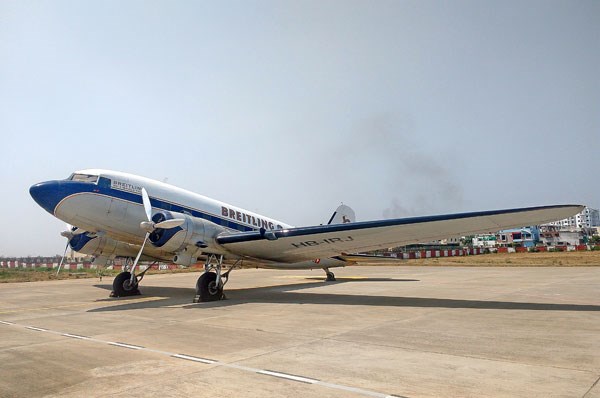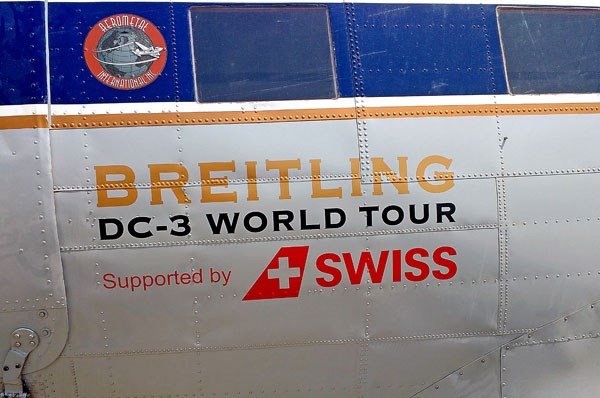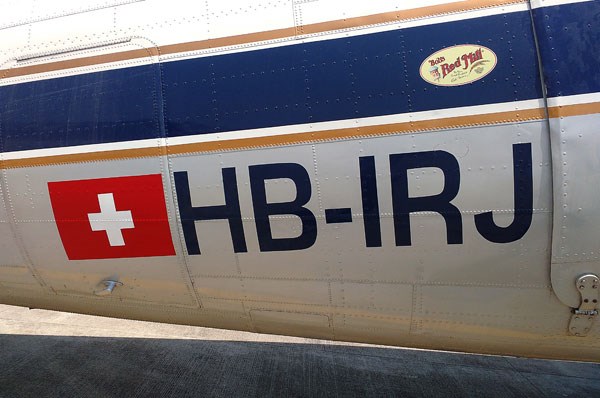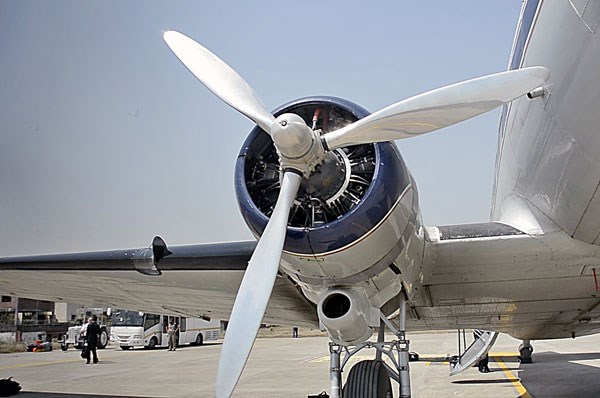We get on board the iconic Breitling DC-3 airplane which has embarked on a world tour.
Published On Apr 25, 2017 12:07:00 PM
15,590 Views
Follow us on



I am one of those automotive aficionados who get fascinated by things that just not move on four wheels but also fly. Recently, I was invited to experience something exactly on those lines. One of the iconic airplanes in aviation history, a 77-year-old small yet mighty Douglas DC-3 had landed in India and I was to come on board for a short flight. The only time I got to see a DC-3 was at the Henry Ford Museum in Detroit a few years ago and so, getting to fly in one surely had me spellbound!

DC-3 is to aviation what Jeep is to automobiles. A rugged airplane that was first produced in 1935 was an instant hit thanks to its low fuel consumption and a fairly long range of its time. The aircraft was manufactured by Douglas Aircraft Company, which built many civil and military carriers like the DC-7 Seven Seas and the long-range DC-8 quad-engine jet in 1958. Some of these old fogies are still flying!
DC-3s were produced as civilian aircraft but had multiple Defence versions, especially for the US military. The military models carried nicknames such as the Douglas C-47 Skytrain and the Douglas Dakota. In World War II, it is said that demand for the Skytrain was so high that the aircraft was produced at the rate of one per hour! The twin-engine aircraft played a leading role in troop transport, particularly in its ‘Dakota’ version. Nicknamed ‘the Normandy landings plane’, it enjoyed its moment of fame in June 1944 by towing countless gliders and dropping thousands of paratroopers on Normandy coasts. The DC-3 airframe that I was on board started life in 1940 with American Airlines, and in 1942 was assigned duty with the US military where it transported troops from Canada to various European destinations. It is said, the aircraft played a role in hunting down German U-boats in the North Atlantic too! Also, out of the handful of DC-3s in flying condition today, this airframe is among the very few 'civilian' models ever made. Douglas made around 250 in this configuration. Nevertheless, production of the DC-3 (C-47 Skytrain) and other military versions ceased in 1942, and of the civilian version in 1945.

In 2008, Breitling, the popular watchmaker that in the past supplied gauges to some of these aircraft, came together with a group of enthusiasts to revive the 1940's DC-3. Aviation enthusiast and bush-pilot Francisco Agullo bought the plane and flew it to Opa Locka in Florida, where it received a major overhaul with Breitling's assistance. The aircraft was then taken to its new home in Switzerland. Called Breitling DC-3A (the A is for having a passenger door on the right), this aircraft has been participating in a number of air shows in Europe as well as in events organised by the brand since 2009. Operated by the Super Constellation Flyers Association based in Switzerland, it accommodates around 30 passengers in its non-pressurised cabin and is equipped for flying under instrument flight rules (IFR). The crew consists of two pilots – owner Agullo and his friend Michael Prophet – and a flight attendant. The aircraft’s cruising speed is 250 kph (130 knots) and can land on most airfields with a hard or grass runway at least 1,100 metres (3,610 ft) long.
Currently on a world tour, which began on March 7 from Geneva, the DC-3 once circumnavigates the globe will be the oldest aircraft in the world to do so. The tour's mission is to raise money for Unicef – Breitling will donate US$ 2 for every nautical mile the aircraft flies for the children affected by Japan earthquake. And to raise money, the DC-3 is carrying 500 limited-edition Breitling Navitimer DC-3 watches for sale that come with a detailed flight log personally signed by the aircraft crew.Before landing in Nagpur, the Breitling DC-3 had already crossed the Balkans (Zagreb, Athens), the Middle East (Tel Aviv, Amman), the Gulf states (Bahrain, Doha, Dubai), and Pakistan (Karachi).
The team selected Nagpur for the India leg as the city is right in the middle of the topography and can supply AV gas, an aviation fuel that the DC-3 needs to fly. Also, Nagpur being a small airport negates the downside of congestion thanks to availability of free airspace which would help us fly around in it. So, it was now time for me to take a sneak peek in aviation history, more closely that Detroit.
The aircraft was parked at a special bay away from the main runway, which coincidentally also has another derelict classic aircraft parked, the Boeing 720. It has been abandoned by its owner. We have seen the DC-3 in countless yesteryear movies and war documentaries; today, coming so close to it was no less thrilling. The first thing you notice when you get near the aircraft is its rakish profile. It tapers towards the back and apart from its main landing gear, gets a small rear wheel. The aircraft has also got a completely restored cabin. It retains its old-school charm through rectangular windows with wooden frames. The seats from an old Douglas DC-9 are although a bit narrow but up to the job. For the world tour, the Breitling DC-3 was reconfigured slightly, which meant the seats at the centre of the fuselage were removed in order to accommodate auxiliary fuel tanks which were connected directly to the main fuel tank. This helps the aircraft to fly longer without taking many fuel stops.

Soon we were seated inside the war veteran and were ready to take off. Captain Agullo gave us a small safety briefing and walked into the cramped cockpit to start the engines. The DC-3 is powered by two Pratt and Whitney 14-cylinder powerplants that churn out close to 1,250hp each. The engines, although state-of-the-art in its times, require a 10min idling to heat up. This meant, we were seated inside the unpressurised cabin of the DC-3 sans AC in scorching Nagpur weather hovering close to 41-deg C at the tarmac. Inside, I wouldn't be surprised if it was a roasting 50 deg. The engine noise had its own old-school charm and was far from the modern day Rolls Royce Trents or the GE90s' smooth hum. Slowly, we taxi towards runway 27. After a long roll and a take-off, we were in the air!
The take-off style of the DC-3 is a bit different from modern aircraft – yes, it's quite slow. The feeling of flying in a relic which we find only in museums and history books was slowly sinking in. We did experience unexpected clear-air turbulence which made the ride a bit more adventurous, if not bumpy. And once it subsided, we were in the cockpit to see how such iconic old-school aircraft are handled in air. It was a quick 20min round above Nagpur skies and my brush with history comes to an end.

The Breitling DC-3's next pitstop was Chang Mai, Thailand, onward to Malaysia, Singapore, the Philippines, China, Taiwan and Japan where it will take part in 'Friendship Day air show'. Following this, it will cross the Pacific Ocean and enter the US via Shemya, Alaska. After multiple stops in the US, the aircraft will go up north to Canada and will make its way into the UK via Reykjavik. It will then visit Paris-Le Bourget, Frankfurt, Milan and then end the tour at the Breitling Sion air show in Geneva, Switzerland, in September. Here's wishing the very best to the crew a successful trip.
Copyright (c) Autocar India. All rights reserved.

Maruti Suzuki plans to use the Boosterjet engine in more models. Which one would you like to see it in?
Swift
33.10%
Baleno
15.21%
Brezza
25.98%
Jimny
25.71%
Get all the latest updates from the automobile universe

Comments
Member Login
Personal Details
No comments yet. Be the first to comment.